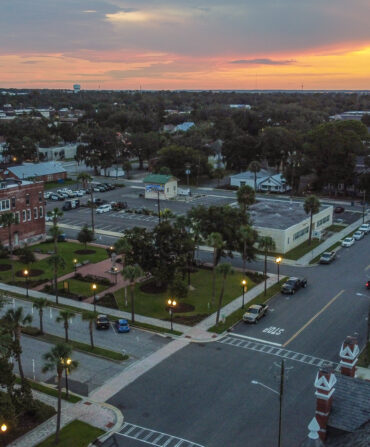
Photo: Harry Taylor
Grave Concerns
A tintype of tokens left by Old Burying Ground visitors, on the grave of the “little girl buried in rum keg.”
Here lies the body of a little girl buried in a rum keg. I know this because the grave marker, a disintegrating slab of cypress more than two hundred years old, has those very words carved into it: LITTLE GIRL BURIED IN RUM KEG. And that’s all it says. The girl’s name may not be well known, but her legend sure is. Just ask anyone in Beaufort, North Carolina, and they can probably tell it to you: She died at sea in the 1700s en route home from a visit to England, and her father—loath to toss her overboard—carried her the rest of the way in a rum keg. These days her grave is piled with tokens left by visitors—necklaces, seashells, a bottle labeled Princess Body Mist, three plastic flowers, a fairy wand, Tweety Bird, stuffed bears, and a doll. I’m the father of a young daughter, and it’s the doll that reminds me there’s an actual child who rests here. It’s a feeling I get often when I visit Beaufort’s legendary Old Burying Ground—that some of the most fantastic stories we hear in this life arise not just from the imagination, but from actual flesh and bone.
The Old Burying Ground—charmingly ramshackle, laid out in almost no discernible order, and wildly overgrown with more than three hundred years of live oak, vine, and azalea—is anchored on three corners by churches. Its entrance faces Ann Street, this historic seaport town’s loveliest road. Measuring no more than 440 feet by 266 feet at its widest point, the plot was deeded to Beaufort as a burying ground in 1731, and while the earliest date of death legible is 1756, many gravestones here are even older, weathered by the centuries, their epitaphs lost to time.
Move along the sandy paths and you pass through the messy crosscurrents of American history. One magnolia drops its large, dried leaves on the graves of four Confederate soldiers, while only steps away lies Sergeant George Johnson, a soldier in the U.S. Colored Infantry. Nearby is Pierre Henry (1812–1887), a black man born free during the time of slavery. Perhaps the most famous grave in the Old Burying Ground is that of Captain Otway Burns (d. 1850), a naval hero in the War of 1812, who slumbers beneath a cannon taken from his own warship. In another grave rests a British naval officer (d. 1700s) who died aboard his ship while in the Beaufort port. It’s said that he didn’t want to be buried “with his boots off,” and so he wasn’t: They buried him standing upright and in full uniform, boots and all.
Patricia Suggs, the executive director of the Beaufort Historical Association, says that the Old Burying Ground is one of the biggest attractions in town. Yet on my last visit, the graveyard was as it has been every other time I’ve seen it: silent and empty. Just the way I like it.
It was 1999 when I first found this place, not knowing a thing about it. I was just visiting my friend Chip, who at the time lived down the street from the Old Burying Ground, which was along my route to the Royal James Café, a pool hall near the waterfront. Walking past the graveyard’s wrought-iron gates that day, I thought why not—the shrimp burger can wait—and stepped through.
On a winter day like that one, the temperature plummets at least ten degrees the moment you cross the threshold. All sunlight is blocked by craggy live oaks grown so intertwined over the years that they’ve formed some type of braided ceiling. A maze of footpaths winds amid the growth below, among which graves are scattered, most in a cluttered confusion of stone, many in sinking beds of brick, others behind intricate ironwork. I remember lifting up the branches of one low azalea that day, only to find an ancient cypress grave marker hidden there within. It looked so fragile I feared that if I even touched it, it might just topple over. Terrified, I gently set the foliage back in place.
My newest novel has a chapter that takes place in the Old Burying Ground, and I’m not the only writer who’s had it in mind recently; Katy Simpson Smith, the author of 2014’s lauded The Story of Land and Sea, constructed her whole novel around the legend of the girl buried in the rum keg.
“When I saw her grave,” Smith says, recalling her first visit to Beaufort several years back, “I thought, maybe I can write a short story about her. Once I started, though, it just kept getting longer and more complicated.”
That Smith’s short story turned into 256 pages comes as no surprise to me. With only the slightest indulgence of the imagination, almost every grave here seems like a placeholder for a novel. Look at Sarah Gibbs (d. 1792). There she lies, right beside her husband Jacob Shepard (d. 1773), who was lost at sea when Sarah was young. She soon married another man, Nathaniel Gibbs, only to have Jacob return years later. The two husbands made an unusual agreement—Sarah would stay with Nathaniel for life, but for eternity she would rest here, beside Jacob.
If that isn’t a novel waiting to be written, I don’t know what is.
Who’s a graveyard for, anyway? Not the dead. They’re dead, after all. To me, it seems a place for the living. The Old Burying Ground is a perfect example. What is it but a celebration of the type of community that might bury a young girl in a rum keg, inter a foreign soldier standing at attention, use a cannon as a grave marker, or lower Sarah Gibbs into the ground beside her once-lost husband? It’s the neighbors today who still lock the gates after dark. The Old Burying Ground is a testament to the vibrant life flowing in and around Beaufort, not its centuries of death.
“Look,” my friend Chip says, while poking around with me recently. “Here are two babies in one grave.” Again, the stories seem to rise from the very ground itself. I kneel to get a closer look. Each child was only a few months old—their deaths separated by only a few years—dead now for more than a century, and my heart breaks as I imagine the grief their parents must have felt so many years ago. I let myself float away for a moment, painting the picture in my mind, until the HVAC unit of the adjacent Ann Street United Methodist Church roars to life at full volume right beside me. I stand up and gasp, almost scared to death. It’s the most alive I’ve felt all day.







